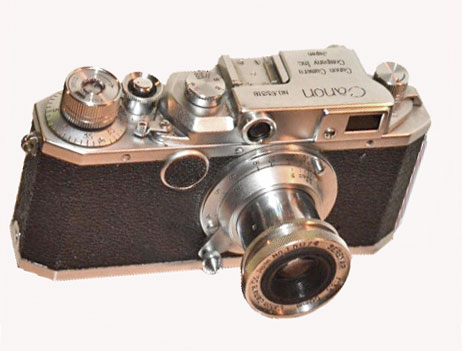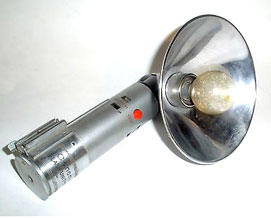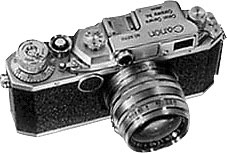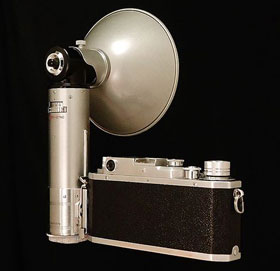Canon IIAF, IIAX Rangefinder Cameras 1953
A Description of rare synchronized Canon cameras manufactured as prototypes in 1953

Canon IIAF rangefinder camera of 1953
Canon Flash Synchronization
In 1950, Canon was working on the development of flash synchronization and associated flash equipment for compact flash bulbs. Electronic flash units, sometimes then called strobes, were not yet widely available for the amateur photographer. The photograph below show the design of flash gun which they were developing.

The bracket at the base of the flash unit was designed to slide into a flash rail to be built into the side of the camera body.

flash rail installed on the side of a Canon camera body 1951
This design was first integrated into a camera body which Dechert refers to as the Canon 1950 since that was the year of its development, although only a few prototype units were made, and it was not commercialized. Only a very few examples have survived.
As we saw in the page devoted to the Canon IV intrduced in April 1951, this flash bar or rail was included first in the IV model for flashbulbs, followed by the Canon IVF and IVS which in addition also feature the universal M39 lens mount and other structural improvements.
With the production of the Canon IIA for Jardine's with no slow shutter speeds, 9 months after the end of the IIA run 1 in June 1953, Canon produced the IIAF with an added flash rail for flashbulb synchronization. It was similar to the Canon IIA without a slow speed dial, and was produced as a prototype. Peter Dechert and others have speculated that this was another model ordered by Jardine, Matheson on which they again reneged.
In any case, very few of these prototype cameras were ever produced - Dechert estimates "exactly 15" produced between June and August 1952. It may be that some expert craftsman could produce cameras matching the Canon IIAF specifications by modifying other Canon rangefinder cameras. In any case, a collector would have little chance obtaining the Canon IIAF camera unless it were such a reconstructed imitation.

Canon IIAF rangefinder camera of 1953
The Canon IIAX
Both Peter Dechert in his fine book Canon Rangefinders 1933-1968 1 and the Canon Camera Museum website 4 make reference to the "Canon IIAX". This is described as a Canon IIA having electronic strobe flash synchronization. Peter Dechert points out that since Canon did not succeed in devising electronic flash X synchronization on the fast speed dial (the Canon IIA and IIAF had no slow speed dial) until 1955, this electronic flash synchronization was not feasible. However, the Canon Camera Museum describes the Canon IIAX as
"a Canon IIA with 1/40 second X-sync and a side flash rail with built-in flash sync contacts. Shutter speeds slower than 1/8 second were not provided." 4
So this would indicate a single shutter dial on the camera top with speeds of 8, 25, X, 50, 100, 250, 500, with X being electronic strobe flash synchronization at 1/40 second.
The Canon Camera Museum also gives a photograph of this model, but states that only about 20 of the Canon IIAF and Canon IIAX these cameras were manufactured - presumably as prototypes. If the Dechert number of 15 for the IIAF is correct, then the Canon IIAX would have been produced as a handfull of prototypes. Interesting for Canon rangefinder history in any case.

Canon IIAX rangefinder prototype as shown in the Canon Camera Museum 4
Canon Flashbulb Units
Canon designed a series of flashbulb units to work with their side rail flash unit connector bar. The Canon Flash Unit X was designed first for the large flash bulbs of the early 1950s, and then changed to accept the smaller flash bulbs of the mid 1950s.

Canon Flash Unit X
Canon later made a series of fan style flashes which could be conneced directly to the Canon flash synch socket which succeeded the flash rail that was built into the 1956 Canon VT, and the Canon L-1, Canon VT deluxe, and later models. You can read about these cameras by clicking on the links below.
You can click on the links in the table below to consult other pages of the canonrangfinder.org site.
| Navigation: Click Below to Jump to Desired Subject Page | ||
|---|---|---|
| Canon Rangefinder Cameras - 1 | Canon Rangefinder Cameras - 2 | Canon Rangefinder Lenses |
| Canon S | Canon IVSB2 | Canon 19mm |
| Canon J | Canon IIS2, IID2, IIF2 | Canon 25mm |
| Canon NS | Canon VT, Canon L2 | Canon 28mm |
| Canon JS | Canon L1, L3 | Canon 35mm |
| Canon J-II | Canon VT Deluxe | Nikkor 50mm |
| Canon S-II | Canon VL, VL2 | Canon 50mm |
| Canon IIB | Canon VI-L, VI-T | Canon 85mm |
| Canon III, IIC, IV | Canon P | Canon 100mm |
| Canon IIIA, IVF, IVS | Canon 7 | Canon 135mm |
| Canon IIA, IID, IID1 | Canon 7s | Canon 200mm-1000mm |
| Canon IVSB | Minolta Rangefinders | Minolta Lenses |
| Canon IIF, IIS | Other Rangefinders | other M39 lenses |
| Go to canonrangefinder.com home page | ||
Any additions or corrections to these pages would be welcome simply by contacting this site as shown at the foot of this page .
Footnotes:
1 Dechert, Peter. Canon Rangefinder Cameras 1933-1968. Hove Collectors Books. West Sussex, United Kingdom. 1985. ISBN 0-906447-30-5.
Peter Dechert's book is the most important expert source of information regarding Canon Rangefinder Cameras.
2 Kitchingman, Peter. Canon M39 Rangefinder Lenses 1939-1971. A Collector's Guide. Published by Peter Kitchingman. Perth, Australia. 2008. ISBN 978-0-646-48144-9.
Peter Kitchingman's book is the definitive study of the more than three decades of M39 format camera lenses developed for Canon Rangefinder Cameras.
3 Nostalgic Canon Camera Book. 懐かしいキヤノン EI Publishing Co. Ltd. Tokyo, Japan. June 2003.
Peter Kitchingman's book is the definitive study of the more than three decades of M39 format camera lenses developed for Canon Rangefinder Cameras.
4 "Canon Camera Museum" history website. https://global.canon/en/c-museum/history/ published by Canon, Inc. accessed in 2019.
5 Rajner, Hans P. (author), John Wade (editor). Leica Copies. Classic Collections Publications. London, UK. ISBN 13: 9781874485056
Hans P. Rajner's book is an excellently detailed and carefully researched study of camera from around the world which used the Leica M39 lens mount and the same lens to film plane distance.
7 Dechert, Peter. Canon Single Lens Reflex Cameras 1959-1991. Historical Camera Publications. Yakima, Washington. 1992. ISBN 1-879561-04-2.
8 Tomlinson, Shawn M. The Film Photography Book. Lulu Pulbications. 2016. ISBN: 9781365263972
9 Sartorius., Ghester. Identifying Leica Lenses. Classic Camera 19. Tokyo, Japan. 2001. ISBN 4-257-12029-0
10 website http://www.nicovandijk.net/rflensmatrix.htm consulted 2019.
11 O'Reagan, Douglas M. Allied Exploitation of German Science after World War II. Johns Hopkins University Press. Baltimore, Maryland. 2019. ISBN 9781421428888
12 website www.canonrangefinder.servehttp.com consulted 2008.
13 Minolta expert Andrea Aprà has posted information on minoltarangefinders group and other groups and further detailed information by email. (thanks Andrea !)
14 website http://www.collection-appareils.fr/objectifs/ consulted 2019.
15 Small, Marc James. Non-Leitz Leica Thread-Mount Lenses. Wittig Books. Hückelhoven, Germany. 1997. ISBN 3-930359-47-2.
16 the Nikon Corporation website: https://imaging.nikon.com/history/ consulted 2019.
17 p 152. Ray, Sidney F. Photographic Lens ISBN 9780240510323
18 website http://www.rokkorfiles.com/Lens%20History.html accessed 2019
If you have any comments or questions about this Canon Rangefinder site, please e-mail me (Larry Huffman) at e-mail address: [email protected]